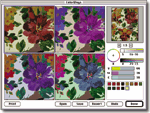Weaving TrendsATI Staff Report Taking Stock OfWeaving Innovation
Technology and trade shape the industrys future.The U.S. textile industrys weaving sector
continues to be shaped by the twin forces of market demands and technological
developments. Market ForcesInternational trade in general and NAFTA in particular have also
shaped U.S. weaving (see Figure 5 and Figure 6). Large imports of apparel and apparel fabrics have
forced U.S. apparel fabric weavers into niches. In addition, as U.S. cut-and-sew operations move
south, the industry appears to be seeing some weaving going with it, particularly for
apparel.Industry observers have told ATI that they expect woven fabrics that require more cutting
and sewing will also move south, while fabrics that require very little cutting and sewing will
remain in place domestically. Labor costs alone, however, may not drive this shift. Higher electric
costs in Mexico and the Caribbean countries may limit the profitability of some textile processes
there, most notably air-jet weaving.One industry observer described the U.S. weaving industry as
having a top and a bottom, but no middle. There are segments like sheeting and denim, in which
economy of scale is everything. Then there are smaller specialty weavers making a wide range of
ultra-high-quality products. Technological FactorsAs weaving machine builders have continued
to offer faster, more versatile looms, the industry has invested to replace older, less productive
machines with newer, faster equipment. As a result, square yards produced per loom hour has just
about doubled since 1990, moving from about 17 square yards per loom hour to almost 40 square yards
per loom hour (see Figure 4).The biggest change in weaving equipment over the last two decades has
been the steady decline of the shuttle loom. In 1987, there were over 75,000 shuttle looms in place
in the United States.As of last year, only around 7,000 shuttle looms remain (see Table 1 and
Figure 1). The watershed year was 1989, the year in which the number of shuttleless looms in place
finally exceeded the number of shuttle looms. It is hard to say whether shuttle machines have truly
bottomed out, because they seem to have found some interesting niches such as vintage denim and
medical applications. However, it is safe to say that they are no longer a significant factor.From
1987 to 1998, the number of shuttleless looms (including air-jet, water-jet, rapier and projectile
machines) dipped from 63,500 machines to 59,800.This decline is testimony to a tremendous increase
in productivity, considering the number of shuttleless machines decreased and at the same time,
they replaced 90 percent of the shuttle looms. Machine NichesA look at shuttleless looms in
place as of the third quarter of 1998 shows air jets with 29 percent, projectile machines with 27
percent, rapiers with 23 percent and water jets with 8 percent (see Figure 3).Of these, air jets
are the fastest growing segment (see Figure 2). Totals alone do not give a complete picture. Each
of these technologies is strong in one or more niches.Air jets dominate sheeting and denim. The
versatility of air jets has increased dramatically over the years. They are now being applied in
diverse areas that would have been impossible a decade ago, including delicate filament styles and
terry pile weaving.Rapiers are major players in apparel, home furnishings and industrial fabrics. A
major strength of these machines is their ability to accommodate a wide range of filling
yarns.Projectiles remain in use in specialty and industrial areas. Their strength continues to be
in the extra-wide segment, where air requirements remove the speed advantage of the air-jet
machines.Water jets are restricted to polyester and nylon filament fabrics, but still show
growth. Dramatic Speed IncreasesLoom speeds creep ever higher. Air jets, for example, have
moved from speeds of 600 rpm to more than 1,000 rpm (at least on the show floor) in a dozen years.
Of course, actual mill speeds are usually somewhat slower and vary by fabric type and construction.
Rapier machines have sped up to the point that they now approach the low end of the air-jet
envelope, say 500 to 600 rpm.Increased weaving speeds mean that warps are consumed much more
quickly. Many weavers have gone to large warp beams to reduce the frequency of warp-outs. Very
large beams (1,600 mm) require new larger slasher heads and improved material handling and beam
storage.To get a clear idea of just how much the speed portion of the equation in weaving has
changed over a dozen years lets compare the machines exhibited at the 1983 Milan ITMA with those
shown at the 1995 Milan ITMA. Weaving 1983Picanol showed an air jet weaving corduroy at 684
rpm. Somets Master SM 92, a 190-cm rapier prototype, was running at 520 rpm.Sulzer Ruti showed a
demonstrator model of its L 5001 L1-1TNS 190 I air jet weaving a suit lining fabric at 720 rpm. The
companys F2001 flexible rapier machine was shown weaving a downproof fabric at 400 rpm.Tsudakoma
demonstrated a 360-cm air jet weaving a poplin fabric at 400 rpm for a weft insertion rate of 1,300
meters per minute. The company also showed a 190-cm loom weaving a taffeta at 700 rpm.Vamatexs P
1001 flexible rapier was shown running at 557 rpm. Picanol showed a Delta F-2-E 190 air jet
weaving a high-twist polyester crepe fabric at 900 rpm. An Omni-2-E 190 was shown weaving a lining
fabric with a viscose warp and acetate filling at 1,500 rpm.Somet showed its Mach 3 prototype
air-jet machine weaving two fabrics at once at 600 rpm for a filling insertion rate of 4,000 meters
per minute. The company also showed its Clipper air jet weaving a cotton downproof fabric at 1,200
rpm.A Thema 11 Excel rapier machine was shown weaving linen shirting at 610 rpm.Sulzer Ruti
unveiled its new M8300 prototype multi-phase air jet weaving print cloth at about 2,700 rpm for a
filling insertion rate of more than 5,000 meters per minute.Tsudakoma showed its ZAX-190-2X-4S air
jet weaving a cotton pinpoint oxford fabric at 1,700 rpm. A ZW405-140-1C-4S water jet produced a
nylon taffeta fabric at 2,000 rpm. The Flexibility FactorWhile speed increases have been
making the headlines over the years, many developments have boosted weaving productivity and
flexibility. These advances include quick-style-change systems, off-loom take-ups, inverter drives,
weft feeders and new monitoring systems.Quick-style-change systems changed the way mills look at
changing loom patterns.Vendors have taken three approaches: The modular machine system, where reed,
harness frames, warp-stop motion, warp beam and frame parts of the machine are disconnected as a
package; The quick connect/disconnect system for all the vital parts of a warp/style change are
used in conjunction with a suitable warp beam truck or other transport; and Modular construction
and specialized transport systems combined. This approach could be used in conjunction with servo
motors and robotic functions and might include automatic guided vehicles or overhead transport
systems for entire style packages.Each major textile exhibition brings more and more sophisticated
quick-style-change systems.The use of off-loom take-ups has grown to the point that a weaving mill
without them is remarkable. Replacement weft feeders are a common option. And loom monitoring
systems are also becoming commonplace.Computer integrated manufacturing (CIM) in the weave mill is
here to stay. Pattern data and machine settings can be downloaded directly to the loom from
workstations. In fact, ATI editors have toured several jacquard weaving facilities where the lines
between the computer design system, production planning system and quality monitoring system have
blurred to the vanishing point.The user friendliness of weaving machines has also improved
dramatically. Todays looms are often equipped with touch screen controls. Production and
maintenance data are displayed in real-time on a unit on the machine itself.If the machine stops,
the reason for the stop and downtime are displayed on-screen. On-board diagnostics tell the
technician which parts to check. This puts the information where it belongs on the production
floor.Electronic let-off and electronic takeup have become universal on weaving machines. Automatic
filling repair, available on air jets since the mid-90s, can now be found on rapier machines. In
the near future, weaving machine automation is expected to include functions like automatic
warp-stop repair, automatic cloth doffing, and perhaps even automatic filling supply systems.The
continuous improvements in spinning technology and yarn quality have also played a role in
increased loom speeds. As a result, fabric quality levels continue to rise, as loom stop levels
continue to decrease.Looking back over the last few major machinery exhibitions, there are many
innovations that have made weaving more productive. ATME-I ’93Dornier demonstrated its new
quick style-change system, further developed since ITMA 91 in Hannover, for the first time on an
air jet.Luwa Bahnson Inc. introduced its LoomSphere humidification system, giving weavers the
flexibility to custom fit conditions to individual looms.Picanol introduced its Delta and Omni
air-jet machines. Both were designed to use that companys rapid style-change system.Stli introduced
its new closed-shed dobby 4080 for industrial fabrics.Sulzer Ruti introduced its own version of a
quick-style-change system.Zellweger Uster exhibited its Delta 200 drawing-in machine for the first
time at a U.S. show. The Delta, since sold to Stli, offered a needed step forward in drawing-in
technology. ITMA ’95 MilanAlexander Machinery Inc. showed the latest version of its off-loom
takeups with a 48-inch lighted lower section for improved fabric inspection.Benninger AG introduced
a completely new weaving preparation system including the Ben-Matic automatic sectional warper, the
Ben-Direct beaming machine for beams with 1,250 mm flange diameter and the Ben-Vac system for
removing dust and fiber during warping.Grob + Co. AG demonstrated the new Optifil thread eye, which
reduced friction on warp yarns and allowed up to 30 percent more healds per frame.Staubli focused
its attention on its new CX 1060 jacquard head, which was shown controlling the shedding for a
30,000-end tapestry fabric.West Point Foundry and Machine Co. showed a new Model 951 warper deigned
to accommodate a 1,270 mm diameter section beam. The new model 950 beam winder for beams with
diameters of up to 1,600 mm was also introduced at the show. ATME-I ’96This show saw a number
of new weaving machine introductions. Nissan
(recently purchased by Toyota, see Supplier Notes pg. 65) introduced the NAX-100A air jet.
It emphasized productivity, improved fabric quality, cost effectiveness, greater reliability, and
easier access and handling.Nuovo Pignone
(purchased last year by Sulzer Ruti, see Sulzer Scales New Heights pg. 32) showed its new
Terry-Jet air jet. Its operation was based on two different beat-up positions of the reed with no
alternate movements of the warp.Picanol introduced its Gamma rapier machine. The Gamma had fewer
moving parts, gears, seals and no timing belts. It was designed for low power consumption and ease
of maintenance. Future ExpectationsTaken as a whole, these trends point to a U.S. weaving
industry with increasingly fewer looms producing more fabric per loom hour.Sulzer Textils M8300
machine may well point the way to the weave mill of the future if its patterning limitations can be
overcome. Patterning considerations aside, the M8300 still offers a compelling look ahead to new
weaving machine concepts.These include modular construction, fly-by-wire communications between
loom modules and weaving mills with entirely different plant layouts. The vertical orientation of
the M8300 with the cloth roll on top points toward overhead cloth roll transport. It is interesting
to note that Somets Mach 3 prototype also shared this vertical orientation with cloth rolls on
top.Certainly the weave mill of the future will be much more fast-paced, computer-integrated and
customer-driven than anything the industry has seen to date.
February 1999






